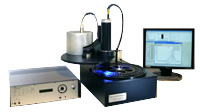Luminescence laboratory
 Optically stimulated luminescence is a versatile technique which can be used to determine the age of a depositional feature such as a glacial moraine and fluvial sediments (OSL dating), the erosion and/or uplift rate of a mountain (OSL thermochronology) or exposure of rocks to light (OSL bedrock exposure dating). The OSL laboratory benefits from specialised rock preparation facilities including two Buehler isomet saws and a recently purchased diamond wire saw. The measurement laboratory is presently equipped with five Risø TL-DA-20 readers, three of which have DASH heads. Our instruments have advanced analytical facilities including time-resolved pulsed-OSL and photon-timer detection, dual infra-red and green laser single-grain dating, CCD imaging for spatially resolved luminescence detection, and an emission spectrometer for wavelength resolved emission detection. In the near future we will also acquire a Lexsyg Research instrument equipped for radiofluorescence measurements. Environmental dose rate measurements are made using an in-house HPGe gamma spectrometer. For field measurements we also have a portable gamma spectrometer and a SUERC portable OSL reader.
Optically stimulated luminescence is a versatile technique which can be used to determine the age of a depositional feature such as a glacial moraine and fluvial sediments (OSL dating), the erosion and/or uplift rate of a mountain (OSL thermochronology) or exposure of rocks to light (OSL bedrock exposure dating). The OSL laboratory benefits from specialised rock preparation facilities including two Buehler isomet saws and a recently purchased diamond wire saw. The measurement laboratory is presently equipped with five Risø TL-DA-20 readers, three of which have DASH heads. Our instruments have advanced analytical facilities including time-resolved pulsed-OSL and photon-timer detection, dual infra-red and green laser single-grain dating, CCD imaging for spatially resolved luminescence detection, and an emission spectrometer for wavelength resolved emission detection. In the near future we will also acquire a Lexsyg Research instrument equipped for radiofluorescence measurements. Environmental dose rate measurements are made using an in-house HPGe gamma spectrometer. For field measurements we also have a portable gamma spectrometer and a SUERC portable OSL reader.
Electron Spin Resonance Laboratory
Electron spin resonance dating is another trapped-charge dating method which measures the concentration of trapped electrons directly, rather than via recombination as for luminescence methods. We recently installed a Magnettech MS5000X X-band bench-top ESR spectrometer, equipped with a liquid nitrogen cooling system. To ensure that we are able to follow the latest ESR measurement protocols, we have also purchased a Freiberg Instruments external X-ray irradiation system and external heating system, allowing us to make measurements on individual aliquots using a single-aliquot regenerative dose protocol.
Computing facilities
Our modeling activities are included within the geocomputing group activities. The cluster park is currently composed of two clusters. The octopus GPU cluster is the flagship machine, composed of 136 Nvidia GeForce GTX Titan X accelerators. The discovery cluster is a 3 nodes GPU/MIC machine, and was designed to test different hardware accelerators and intra-node memory bandwidth optimization.
